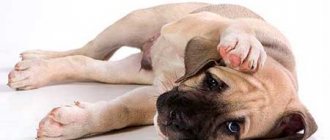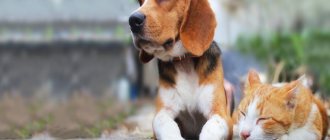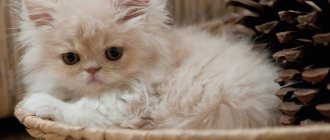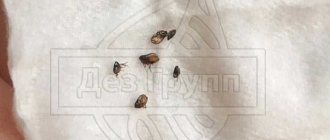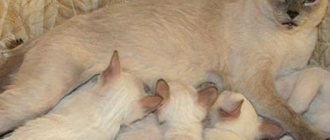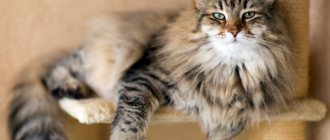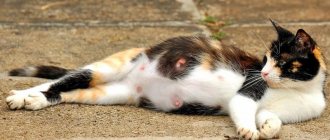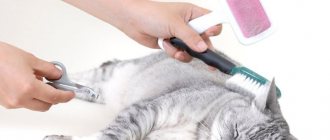The cat is bearing offspring, but she has fleas. An extremely unpleasant situation! The process of removing fleas from a pregnant cat should be approached with the utmost responsibility and caution. The thing is that even means that are absolutely harmless for an adult animal can negatively affect the offspring, complicate the course of pregnancy, and even lead to miscarriages.
The basic rule for flea treatment for a pregnant cat is to prevent the drug from getting ingested. In view of this, the best flea treatments for pregnant cats include:
- gentle shampoos;
- flea collars;
- drops against parasites (strictly with the permission of a veterinarian).
The shampoo and collar do not have a sufficient concentration of the product for it to enter the animal's blood or milk. However, if a cat does not tolerate bathing well, there is no need to expose it to such stress during such an important period of life. When using a flea collar, be sure to remove it afterwards. It is not recommended for a pregnant cat to leave or wear a flea collar as a preventive measure.
Note!
Fleas in a pregnant cat, after the birth of kittens, will almost immediately spread to the babies. Fleas can cause more harm to a small kitten than to an adult animal. For example, they can infect kittens with worms. Cause a number of dermatological diseases that can have fatal consequences for a kitten’s fragile body.
Effective flea treatments for cats
Effective flea remedies require one-time use and prolonged action. Only insecticides can give this effect. Folk remedies do not help immediately and quickly, so they require regular use until the parasites are completely eliminated.
The following products can be used to control fleas:
- Drops.
- Sprays (this also includes any repellents that need to be sprayed into the air).
- Shampoo (this also includes powders and powders).
- Collars.
- Folk remedies.
Regardless of the product you choose, parasite control will not be effective if you only treat the animal. It is important to remember that if you have several pets, you need to treat all of them, regardless of who became infected first. If the flea infestation has developed for more than two weeks, you will most likely have to treat your home as well.
Danger of parasites
It is extremely important to remove fleas from a pregnant cat as quickly as possible, as the parasites can pose a particular danger to newborn kittens, who become infected from the mother while nursing.
Fleas are carriers of the following infectious diseases:
- brucellosis;
- rickettsiosis;
- panleukopenia;
- different types of typhus;
- anthrax;
- leprosy;
- plague;
- helminthiasis.
Fleas are carriers of diseases.
Adult cats are immune to many of these pathologies, but for kittens they are extremely dangerous. In addition, parasite bites often cause the development of allergic dermatitis in newborn animals. Constant loss of blood leads to the fact that young animals grow slowly. Signs of anemia may appear.
The animal's body weakens and becomes more susceptible to other infectious diseases. The situation is complicated by the fact that newborn kittens cannot be treated even with gentle antiparasitic agents.
The body of a young animal may not be able to withstand the toxic load, which will lead to poisoning and death.
Flea shampoo for cats
Shampoo for fleas on cats is a familiar, one might say, traditional preventive remedy. Note that antiparasitic shampoos are always liquid, since insecticides in the form of powder or powder are very dangerous to work with.
When working with liquid shampoo, it is important to follow the following rules:
- Do not pour on the cat's head; make sure that water and foam do not get into the ears or mucous membranes.
- Stir the shampoo in a bowl of water, then pour the foamed liquid along the animal’s spine.
- When using shampoo, it is important to cover the pet’s body with foam; it is this that creates an oxygen-free barrier that enhances the effect of the insecticide.
- The foam should be kept on the fur for at least 5-10 minutes; if the cat is very panicked, it should be wrapped in a towel and carried in your arms, calming it down.
- Rinse off the foam with running water until bubbles stop forming on the wool.
- After bathing, dry the coat as much as possible with a towel or hairdryer.
The following shampoos can be used to treat adult and young cats:
- Celandine.
- Leopard.
- Dana.
- Lugovoy.
- Rolf Club.
- Ms.Kiss – there is a series for kittens.
- Phytoelite.
- Beafar.
- Doctor Zoo.
- BioGroom.
- Gin Fort.
- Bio Wax.
- Veterinary Formula
- Gamma – there is a line for kittens.
- SynergyLabs.
Important! For bathing kittens, it is better to use phyto-shampoos with repellents of natural origin: herbs and essential oils.
Symptoms of the presence of “living creatures”
Fleas, lice, lice and other living creatures are quite frequent guests of pets. And even if the cat has never left the apartment, insects can settle on the animal if they get into the room with the shoes and clothes of household members.
An experienced owner treats the coat against fleas before mating the animal. However, trouble often happens after mating, during the pet’s pregnancy. Signs of parasite infection do not appear immediately. At first, the animal’s behavior is unremarkable, however, as the number of “tenants” increases, the symptoms also increase.
The owner begins to notice that his pet is behaving restlessly: she often bites herself, literally bites into the skin, and becomes nervous due to bites and itchy skin. Most often it itches in the head, abdomen and at the base of the tail. Often, the owner may notice that the cat meows and immediately begins to itch. Upon examination, traces of scratching and crusts of dried blood are visible on the skin. You should know that even a thorough examination of the skin does not always allow visual identification of parasites. But traces of their presence (excrement in the form of dry dark crumbs between the hairs) are not difficult to detect.
Flea collar for cats
A flea collar for cats is a means of additional prevention. It is important to understand that the collar itself does not work, since its main function is to repel parasites. The collar is used after bathing or treatment with flea drops.
To prevent flea infestation in cats, you can use the following collars:
- Beafar is a phyto-series.
- Hartz.
- Barrier.
- Leopard.
- Doctor Zoo - there is a phyto-series.
- Celandine.
- Dana.
- Kiltix.
- Rolf Club.
- Bolfo.
- Vitomax is a phyto-series.
- Foresto.
- Green Fort.
Important! To prevent flea infestations in kittens under 3 months of age, the use of collars is not recommended if the pet does not have free access to the outdoors. To date, there is no clear guarantee that phyto-collars do not have a detrimental effect on the growth and development of growing cats.
How to detect?
Fleas live on the kitten's neck and back, so a thorough examination should begin from there. Insect bites cause itching, so you should look for scratches and wounds.
You can see black lumps on the kitten's undercoat - these are traces of flea activity. To make sure they are present, you can rub the animal’s back on a white paper towel. The presence of red-brown marks will confirm fears that this is feces containing undigested blood.
The behavior of kittens may indicate the presence of parasites: the animals behave nervously, are frightened by any rustling sounds, and do not want to play. If a mother cat itches intensely and chews insects with her teeth, this also indicates the presence of fleas.
Folk remedies for fleas in cats - essential oils, herbs
Folk remedies have more of a preventive than a therapeutic effect. Usually, folk remedies are used as an additional remedy. Exceptions are the treatment of kittens under 1 month of age, pregnant, weakened, lactating and sick cats.
Effective folk remedies against fleas are:
- Essential oils - fleas avoid the smells of eucalyptus, pine needles, tea tree, lemon balm, and lavender.
- Herbs – wormwood, tansy, eucalyptus, geranium leaves.
- Coniferous sawdust – repels fleas from the pet’s sleeping area.
- Infusions for combing - lemon is usually used for preparation.
Garlic is a toxic agent with a good preventive effect. Just chop a few cloves of garlic, add water and leave. The resulting infusion is applied to the fur to repel fleas and ticks.
The downside is that it is toxic to cats when licked. To enhance the effect, garlic is mixed with yeast, poured with water and infused.
Treatment of kittens
Kittens have a rather weak immune system and are much more susceptible to all the symptoms of the disease. The consequence of flea bites is the appearance of anemia, and in severe cases, death is possible.
You should protect your cat from flea infestations by taking preventative measures.
- Most drugs are prohibited for use in kittens. Treating them with strong agents intended for treating adult cats is strictly prohibited. The most gentle and effective method for controlling fleas at home is the mechanical method of combing out fleas using special combs. This method is quite labor-intensive, but is best suited for kittens.
- Another effective and approved method for removing fleas from children is the use of proven and safe Frontline or Stronghold shampoos.
- It is allowed to combine treatment of kittens against ectoparasites with the use of anthelmintic drugs.
- A very effective and safe remedy is a self-prepared composition of 150 ml of inexpensive shampoo for kittens with an ampoule of “Neostomazan”.
Prevention of fleas in cats at home - general rules
Ridding your pet of fleas at home is quite simple, and if you follow simple rules, the procedure will be safe.
To combat fleas, you can choose professional or folk remedies.
- When using professional remedies, you will win faster if the cat has just become infected - after the first use.
- When using folk remedies, the fight will last at least a month, and if fleas have already settled in the home... folk remedies are practically powerless.
When using industrial insecticides, it is important to observe safety and personal hygiene measures.
In rare cases, cats have an allergic reaction even to the highest quality medications and it is almost impossible to predict. In addition, when using insecticides there is a risk of overdose and poisoning.
Important! Even the best quality flea products will not protect your pet for more than 2 months! Shampoos protect your cat for 2-3 days, most drops last 4-8 weeks, collars last 2-3 months (or a little longer).
How to rid a pregnant cat of fleas
Conditionally safe flea drops that are used to prevent infestations in a pregnant cat:
- Frontline.
- Advantage.
- Stronghold.
Conditionally safe flea shampoos:
- Lugovoy.
- Doctor Zoo.
- Biovax.
Conditionally safe bio-collars:
- Doctor Zoo.
- Beaphar Bio Band.
Note! Most veterinarians do not recommend using flea collars while your cat is pregnant. If your pet walks outside, it is wiser to limit its freedom and protect it from constant contact with insecticides.
Prevention of fleas in a nursing cat
When a cat is feeding kittens, parasite prevention becomes an extremely dangerous undertaking. Poisons penetrate milk faster and easier. While the cat is in constant contact with the kittens, her fur, lymph and skin should be clean. The use of any preventive shampoos is extremely undesirable, since it is still impossible to completely wash the foam out of the wool.
The optimal method of controlling fleas in a nursing cat and her offspring is considered to be external means and manual elimination of parasites.
You will not harm the kittens if you place wormwood or a mattress with fresh sawdust under the nest. Kittens can be combed, picking out fleas and even treated with herbal infusions. Selecting fleas by hand is more difficult, but doable. If there are a lot of parasites, there are no special alternatives - only drops.
Conditionally safe flea drops that are used to prevent infestations in a nursing cat are Advantage. The drug is not absorbed into the skin or lymph, is distributed over the skin, and protects the pet and the nest with kittens from fleas. Recently, Stronghold has also been used to treat nursing cats, but strictly as prescribed by a veterinarian.
What to do if your cat is poisoned?
There are only two reasons why a cat can be poisoned by prophylactic drugs: an overdose or individual intolerance to the components of the drug. In the first case, the instructions for action are more clear - you need to remove the poison from the body as quickly as possible.
If your cat is poisoned after using the drops, you should:
- Thoroughly wash the area where the drops are applied with shampoo.
- If the drops are oily, the fur should be wiped with paper napkins soaked in vinegar.
- There is no need to induce vomiting (it is useless), but adsorbents should be given.
- If the cat vomits, drink the rehydron solution.
- Take the cat to the veterinarian.
If your cat accidentally swallows shampoo or flea drops:
- In order to induce vomiting, a 3% solution of hydrogen peroxide is poured in 1/3 teaspoon every 3-5 minutes. Vomiting occurs after 2–2 doses. Maximum dosage 1 teaspoon per 5 kg.
- Adsorbents: atoxyl, activated carbon, enterosgel.
- To rinse the intestines - an enema with enterosgel or clean water.
- To prevent dehydration during vomiting and diarrhea - rehydron solution.
- To preserve the integrity of the intestinal mucous membranes - smecta.
Note! Hypothetically, a cat could be poisoned by flea medications, even if you follow all the dosages. Intoxication is possible due to individual intolerance to the active ingredients of the drugs. To reduce risks, monitor your pet’s condition for at least 2–3 hours after treatment.
Safety of disposal
It is imperative to treat an infected cat when she is pregnant. Constant bites and discomfort experienced by the animal can lead to nervous exhaustion.
In addition, being carriers of dangerous infections, parasites can infect the animal with tularemia or hemobartonellosis.
Immediately after birth, fleas infest the kittens' fur. They can cause much more harm to newborn babies than to an adult animal, for example, infecting them with worms or leading to anemia.
For a fragile kitten or a cat weakened by childbirth, the consequences of fleas can be fatal.
Fleas often contribute to:
- animal exhaustion;
- infection with worms;
- baldness;
- the occurrence of allergic dermatitis;
- infection of pets;
- constant nervousness of animals.
When carrying out disinfestation, special attention should be paid to the safety of use. Otherwise, you can harm not only the pregnant pet, but also her offspring.
Home flea treatment products – Butox, herbs and others
Home treatment is not always relevant. If you are bitten by fleas, especially at night, you need to treat your house, and urgently! Every day fleas lay eggs, from which new armies of parasites will hatch and increase the population exponentially.
To treat the home use:
- Butox, Neostomazan and other solutions - treatment is carried out in an empty room from the floor to a height of 1.2 meters. After treatment, the room is closed for 1–2 hours. Afterwards, the room is ventilated and wet cleaned. Butox and analogues are toxic to warm-blooded animals and plants.
- Soda and vinegar - the room is covered with soda around the perimeter. The soda is mixed a little and the room is closed for a day. Afterwards, you need to remove the soda and wash the floor with vinegar. Soda vapor is toxic to warm-blooded animals and plants.
- Wormwood - grass is laid out on floor surfaces. The wormwood begins to dry out and release an oily substance with a distinct odor. After the smell is exhausted, the grass is changed. Wormwood oil and vapor are non-toxic to animals, people and plants.
Veterinarian advice
- Most often, the appearance of fleas on a pet is the result of a violation of basic hygiene rules.
- The flea population is enormous in size and no more than 5% of the total number parasitizes the animal’s body.
- Fleas can infest not only sleeping areas and pet carriers, but also actively breed behind baseboards and in other cracks and seams.
- According to experts, daily use of a vacuum cleaner can reduce the ectoparasite population by almost 50%.
By being patient and armed with our advice, you can alleviate the difficult situation of your pregnant cat and protect her offspring from encountering parasites.
Reasons for appearance
Fleas run from one animal to another - this is the main reason for the appearance of the scourge. Initially, parasites can be acquired from your pet's mother - the cat needs to be examined first. If a kitten runs around the street, there is a chance of catching an infection from yard cats. Fleas also hide on our clothes (pants, socks). Bloodsuckers love to live in warm basements, and the time it takes for a flea to hatch from a larva is on average 21 days.
